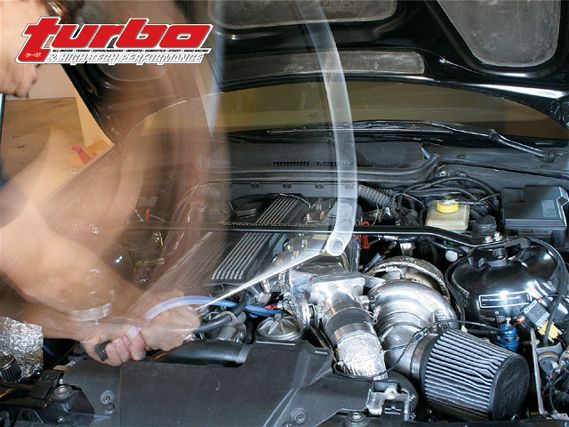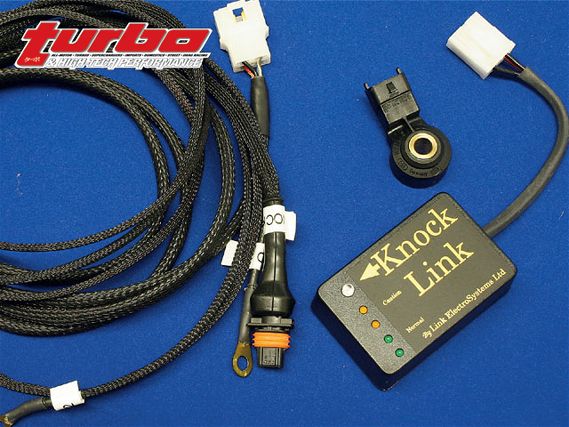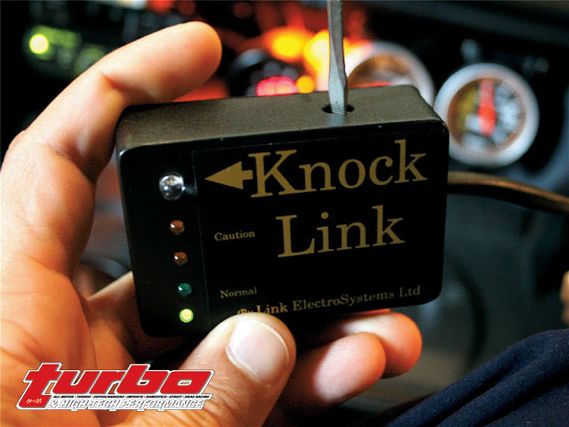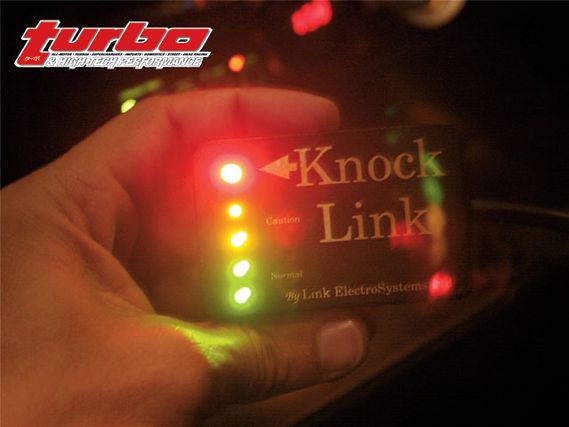 | Knock Sensor Monitor - Knock Link
| Knock Sensor Monitor - Knock Link
Dyno tuning is great. But, a dyno-tuned engine can't always be tuned for the stress it might see on the street, let alone something like the continued abuse of, say, a track day. This is especially true if we're talking non-loading dynos. For one thing, the ambient weather could be much hotter than during testing. Or, the 140mph wind pushing against the car at speed could keep the engine in gear longer, causing more heat in the engine. In either case the knock sensors could be going wild, but without a stand-alone and lap top in view most drivers have no idea, ignorantly keeping their foot on the throttle.
Many stand-alone engine management systems are capable of ignition retard and fuel enrichment when knock is picked up. Still, wouldn't it be nice to know if you further needed to drop the boost or ignition given the current conditions and fuel octane, instead of only relying on the ECU's ability to perform instant damage control before a catastrophic engine failure? When you start getting into specific outputs exceeding 100 lb-ft of wheel torque per engine liter, the margin of safety for detonation becomes increasingly small before something potentially bad happens from all of that cylinder pressure.
 | Knock Sensor Monitor - Knock Link
| Knock Sensor Monitor - Knock Link
Distributed by Performance Developments, the Knock Link is a fairly simple device using its own knock sensor, which triggers a set of LED lights. It's important to note that it doesn't control or prevent detonation - it only monitors the noises possibly caused by it or pre-ignition. "It's a very inexpensive way to warn you before you've got the damage," says Performance Developments founder Neil Harvey. "And sure, it's true that the damage could already have been done (if the detonation was bad enough), but if not, you at least have the opportunity to know that if done continually, what you're currently doing could potentially lead to engine damage."
The LED lights on the Knock Link readout show only background noise, which will rise exponentially with engine noise (namely torque) and in a way you can easily decipher from. The two green lights indicate normal operating engine noise, while the two orange lights tell you to take caution. A sudden rise in engine noise will light up the bright red "Knock" light, which tells you something other than normal engine noise is happening, and is most likely detonation.
 | Knock Sensor Monitor - Knock Link
| Knock Sensor Monitor - Knock Link
The unit has a sensitivity-adjustable screw, which will make this unit work for any vehicle. It's very easy to set up. Let's say our vehicle in question peaks torque around 4000 rpm. We will assume your car is not detonating at idle (if it is, kill your tuner). What you do is free-rev the car up to 4000 rpm and turn the screw clockwise until you get one green light to light up. What you've done here is filtered out normal mechanical engine noise. Any extra vibrations encountered by our Knock Link's knock sensor will show up on the LED readout. Your goal is to stay green on a full sweep of the rpm at the load you repeatedly drive at.
We've been testing our Knock Link on a turbocharged E36 BMW M3 for the past year - it's a neat little device. Since the car is controlled by a stand-alone engine management system, sure, we could monitor the factory knock sensors' activity voltage output if we wanted to, but that would require us to have an opened lap top in the passenger seat, which would require taking our eyes off the road during a wide-open throttle run. We could also simply log the run to look at later, but what if the car was detonating during that entire pull and we didn't know to immediately get off the throttle? With the Knock Link we can hook it up anywhere (or have it in hand), and easily monitor engine noise as it happens.
 | Knock Sensor Monitor - Knock Link
| Knock Sensor Monitor - Knock Link
During our usage we noticed the Knock Link can be extremely consistent and sensitive at the same time. First off, it never fails that if we drive the car part-throttle in first gear - or any gear for that matter - we'll see one green light displayed as expected. On a full sweep in third or fourth gear the Knock Link registers that one green light at 10-12 psi, which gives us peace of mind, given the tune. At 15 psi, the pump octane becomes questionable and starts to trigger one, and sometimes both, orange "caution" lights. But, if we add a couple of gallons of racing fuel to a full tank of pump fuel, the lights go back to green. The only time we triggered a couple of red flashes on pump fuel was if the boost controller was turned past 16 psi, which is starting to exceed 500 whp on this car. The registered noise isn't audible to the naked ear, but the Knock Link tells us at this boost level, given the tune and octane, that maybe it isn't a good idea to keep our foot on the throttle.
Perhaps the decision to get off the throttle has to happen during a grudge encounter with a Corvette Z06 or a Dodge Viper, and we realize it's easier to stop leaving the toilet seat up for our wives than to lose this race - who knows? Like the subconscious mind telling us the bad from the good, the Knock Link tells us this continual behavior can't be good for our engine (or our wallets).
The Knock Link comes with a terminated harness, a knock sensor and a Knock Link LED display for $328. For the more serious, the tuning shop Performance Developments also has a Knock Block available for $625, which uses two knock sensors and a set of headphones to actually listen for, and hear, engine knock. If we were offering a dyno testing service, this would be something we'd consider offering to the customer as an option. It's easy to hook up and calibrate, and you could make a few extra bucks in the process. And who knows, maybe you could be saving someone a costly engine rebuild in the near future.
